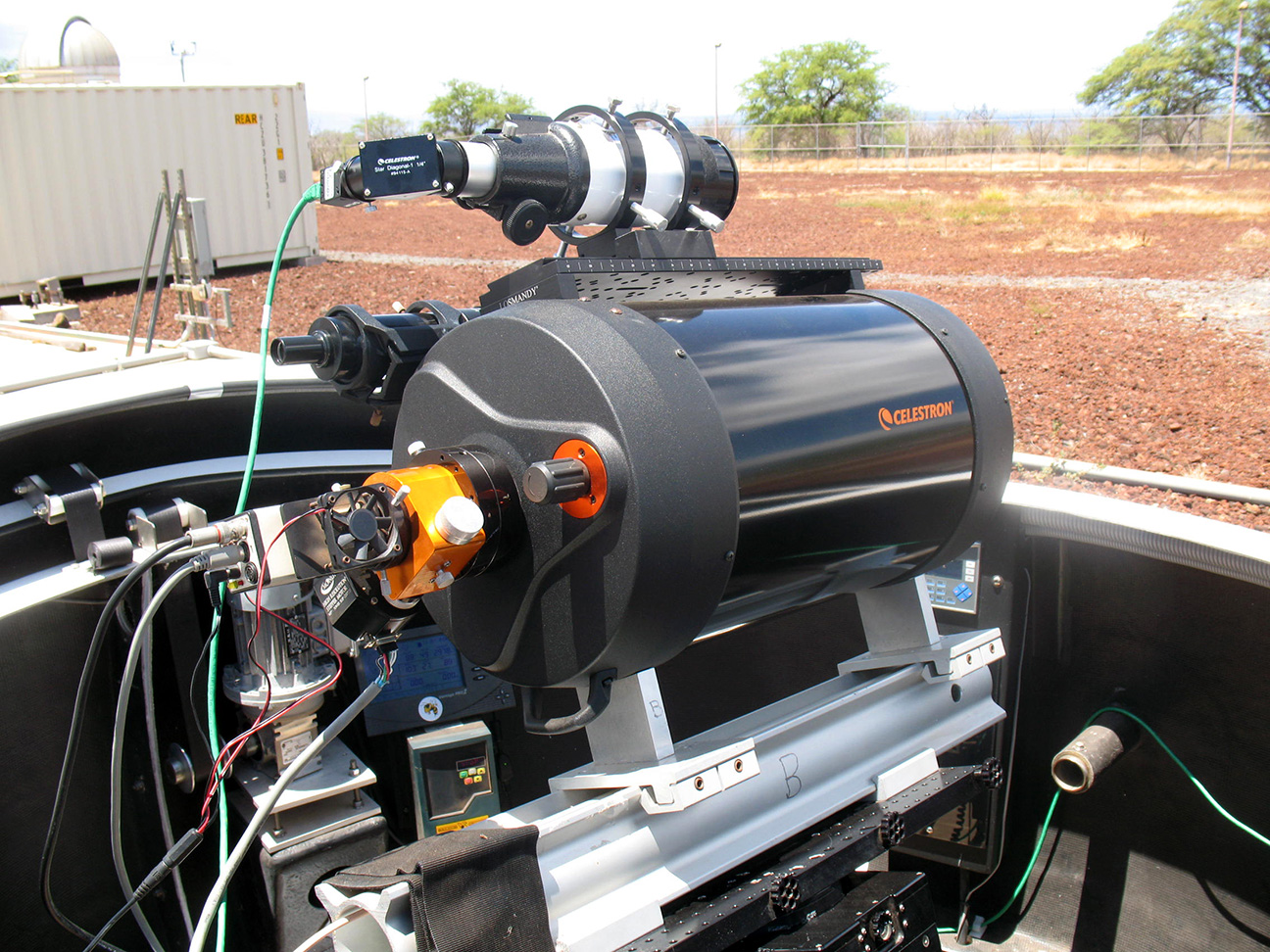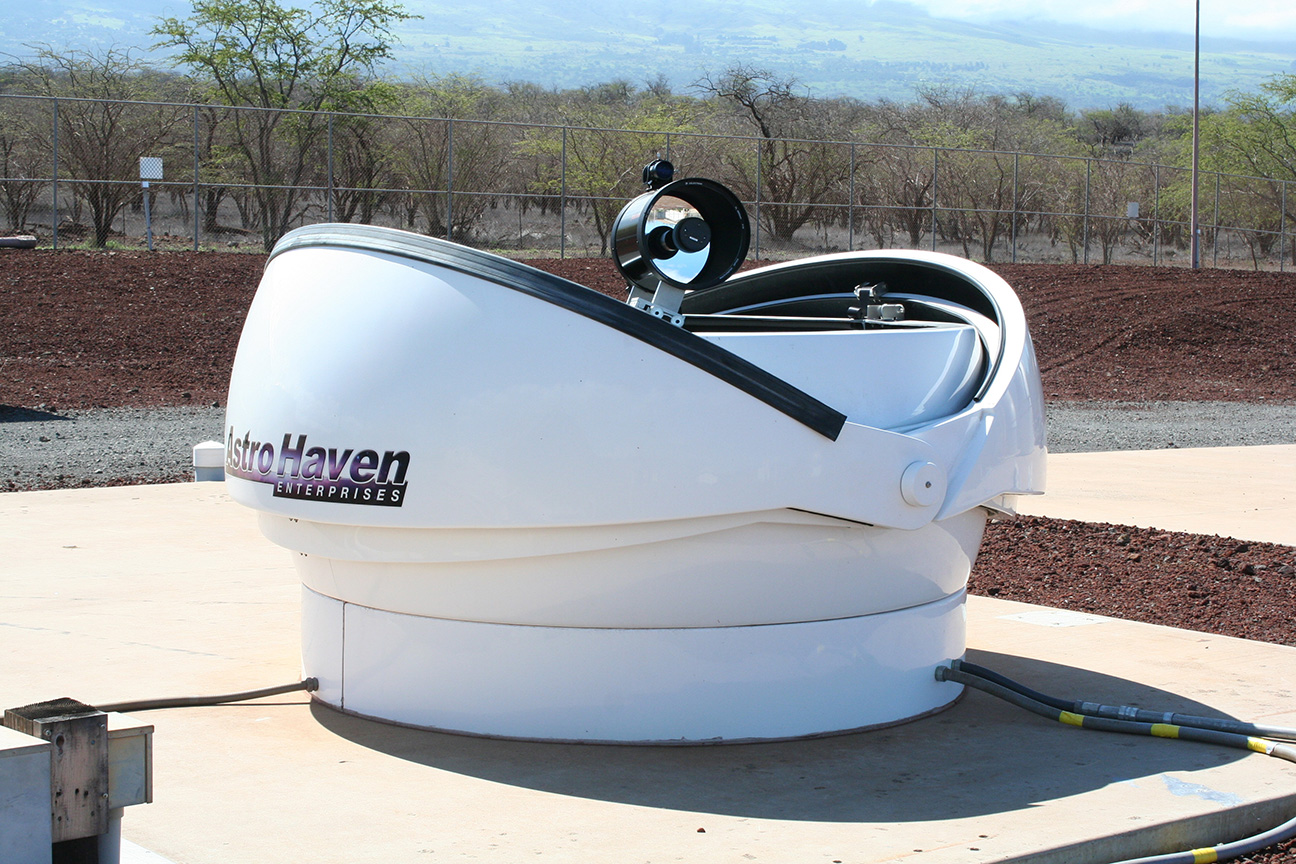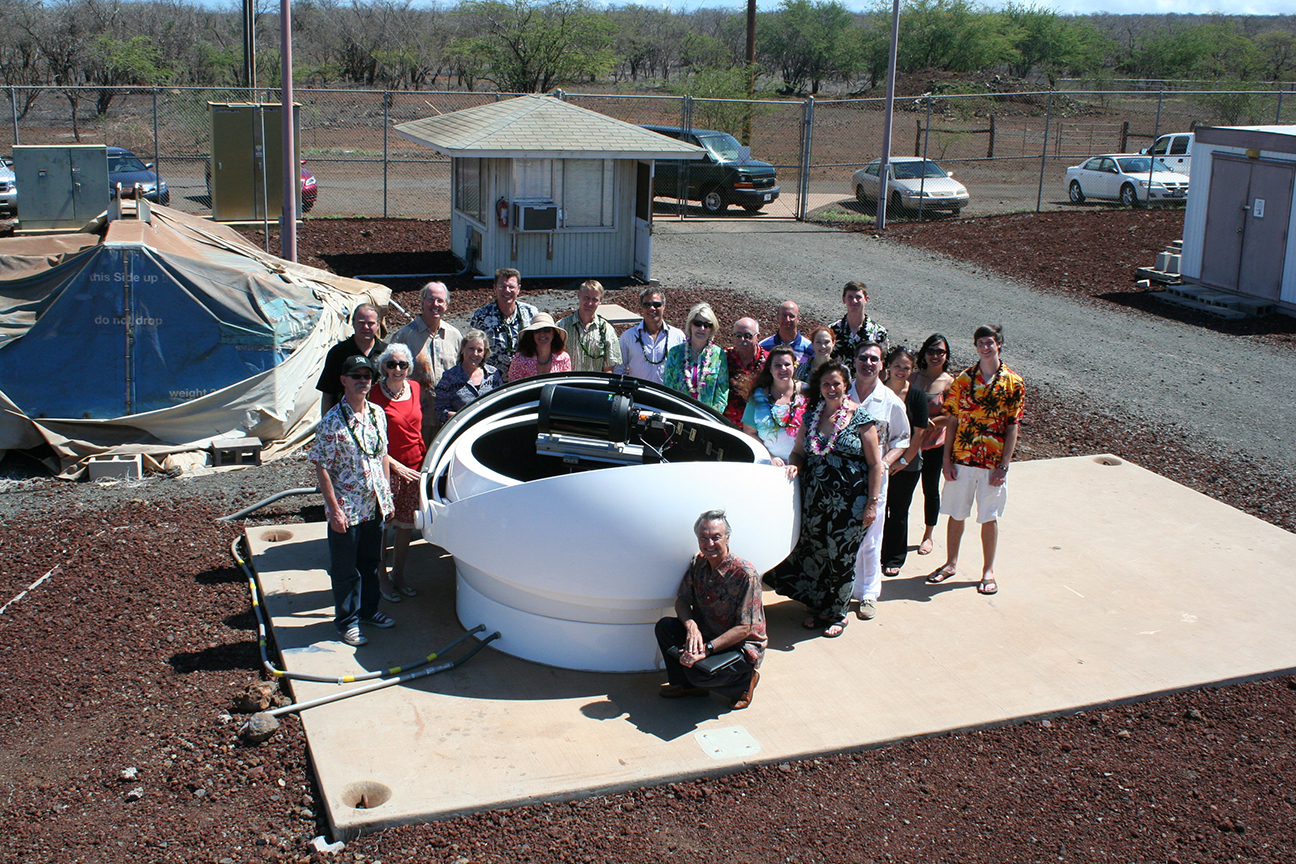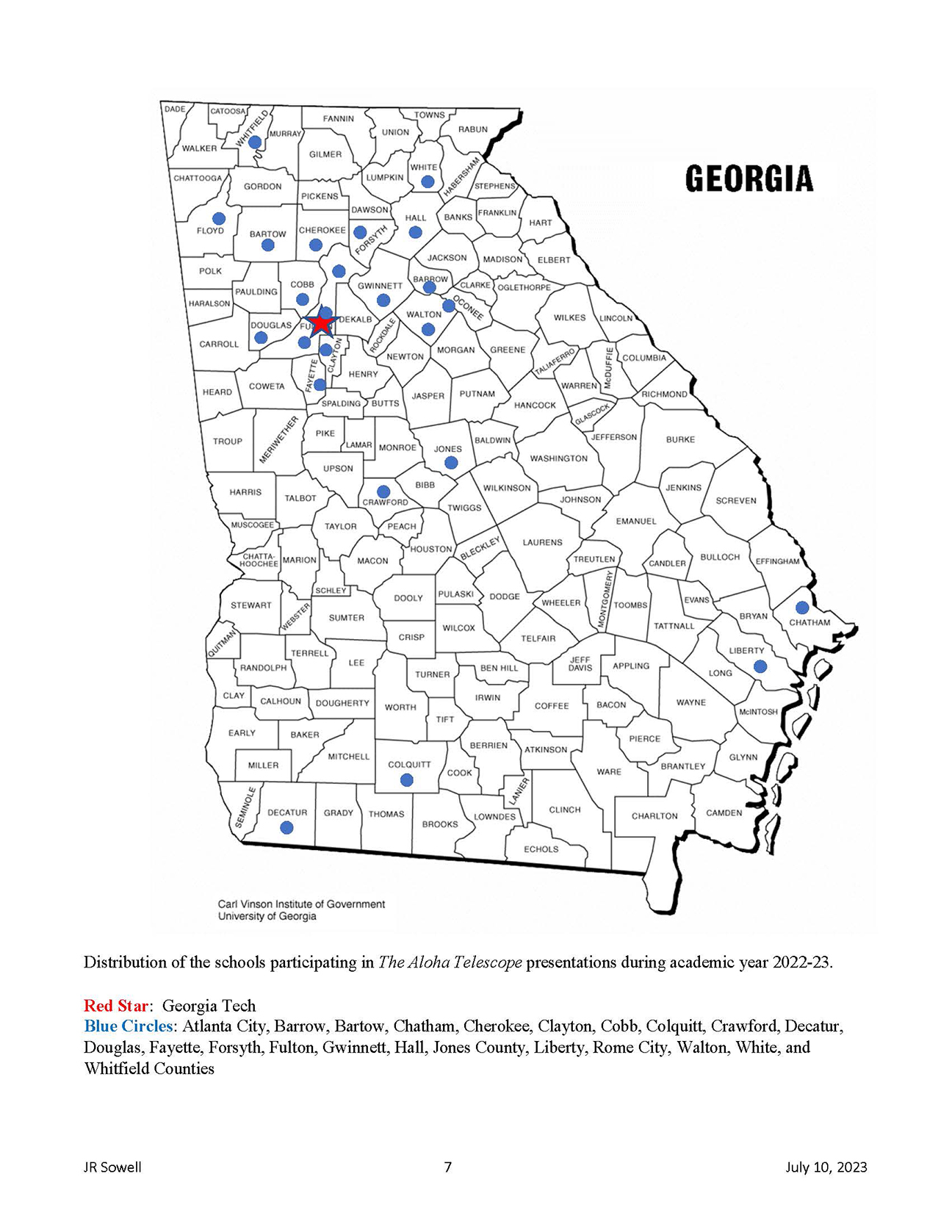KIRTLAND AIR FORCE BASE, N.M. (AFRL) – It’s been 10 years since the Air Force Research Laboratory, or AFRL, successfully launched the astronomy outreach program called Aloha Explorations at the Air Force Maui Optical and Supercomputing site, or AMOS, in Maui, Hawaii. The STEM outreach project involving AFRL, the Georgia Institute of Technology and the University of Hawaii encourages grade school- to university-level students to learn more about astronomy and explore the different career paths that science, technology, engineering and math have to offer.

From left: Dr. Shadi Naderi, Air Force Research Laboratory research scientist and STEM technical lead; Capt. Charles Schramka, Air Force Research Laboratory research scientist; Scott Hunt, technical director for the Air Force Research Laboratory’s Directed Energy Directorate and 15th Space Surveillance Squadron; and Maj. Keegan McCoy, research flight commander for the Air Force Research Laboratory’s Directed Energy Directorate and 15th Space Surveillance Squadron, stand in front of the Aloha telescope in commemoration of the outreach program’s 10-year anniversary, March 29, 2024.The astronomy outreach program has reached 6,000 students and 175 teachers over the last two years with the capability to view the moon and other objects in space. (U.S. Air Force photo / Shadi Naderi)
“We are always on the lookout for talented individuals in these fields,” said Dr. Shadi Naderi, outreach technical lead for the 15th Space Surveillance Squadron. “At AFRL, inspiring the next generation’s interest in science, engineering, technology and math is a core part of our mission. We aim to encourage more American students to explore the realms of science, engineering, and technology. Let’s spark their curiosity and demonstrate the thrilling opportunities that await them in these careers.”
Aloha Explorations uses an 11-inch Celestron telescope, also known as the Aloha Telescope, to provide students in grades K-12 the ability to view live images from their classrooms and remotely control the telescope via an internet connection. The idea originated from Dr. James Sowell, an astronomer and observatory director at the Georgia Institute of Technology’s School of Physics. Sowell recalled when he first submitted his idea as a research proposal to the new chair of the department at the time.

Aloha Explorations uses an 11-inch Celestron telescope, also known as the Aloha Telescope, to provide students in grades K-12 the ability to view live images from their classrooms and remotely control the telescope via an internet connection. Most of the telescopes at the AMOS site are positioned at 10,000 feet on the summit of the dormant volcano Haleakala and are used for research and development for space domain awareness. The smaller outreach telescope is much more convenient for the students in Maui to access and learn more about astronomy. (U.S. Air Force photo / Shadi Naderi)
“It’s like a telescope camera and a long USB cable connecting to them,” Sowell said. “With small cameras in our campus telescope, we’d sent views of Saturn to an all-girls school in Australia, but it was close to midnight. This wasn’t a problem for me, but the crew that was helping me they’re not used to that. A month later, we were doing Great Britain schools at about four in the morning. That was when the light bulb went off. I’m doing this backward — we should not be the dark site with the telescope. Rather, we need to put our own telescope in a dark, remote location that we can remotely control during our day.”
Being that these outreach sessions happened at all hours of the night, Naderi said this makes it difficult especially for those with children at home and makes planning more difficult.

At the Air Force Maui Optical and Supercomputing site located at Kihei, Maui, Hawaii, the 11-inch diameter telescope in its clam-shell dome donated for science, technology, engineering and math outreach. From the annual conference, a team of volunteer scientists, some from NASA and some from AFRL, physically lift the dome for transport to the dedicated AFRL site. (U.S. Air Force photo / Shadi Naderi)
“That’s when Dr. Sowell proposed a brilliant solution,” Naderi said. “By strategically placing the telescope on Maui, they can access it during morning or afternoon hours from Georgia, allowing teachers and students in Georgia to experience real-time views of the night sky right from their classrooms during the daytime.”
At the Maui site, Dr. Stacie Williams, space science architect for AFRL’s Office of Scientific Research, or AFOSR, served as a tech adviser at the genesis of Aloha Explorations. As an integral part of the outreach program’s start-up, Williams recounted the beginning of the partnership with Sowell.
“Jim wanted to put the telescope on Maui,” said Williams. “He had been trying all kinds of ways to do that and it hadn’t worked out at other geographic locations. He told me about his ideas for outreach and I thought it was a great way to engage the students in Hawaii with the telescope because they would see the big telescope, but they couldn’t touch it or use it. So, I thought this was a way to that the students in Hawaii could also have access to a smaller, teaching telescope.”

A live image from AllSkyImage, the software used for the Aloha Telescope showing clear skies over Kihei, Maui, Hawaii, May 5, 2017. The telescope in Maui was accessed during school hours to allow Georgia teachers and students the opportunity to experience real-time views of the night sky right from their classrooms during the daytime via internet connection. (Courtesy photo / James Sowell)
Most of the telescopes at the AMOS site are positioned at 10,000 feet on the summit of the dormant volcano Haleakala and are used for research and development for space domain awareness. The high altitude provides a better position for the large telescopes. For smaller telescopes, such as the Aloha Telescope, they operate well at sea level, which is much more convenient for the students in Maui to access, according to Naderi.
“It’s quite challenging to make the trek up to the summit, which takes almost two hours from sea level where most of Maui’s population resides,” Naderi said. “Having an outreach telescope at sea level provides a fantastic opportunity for easier access and engagement for the community.”
Telescopes are packed with sensitive and expensive optical and electronic components. A dome provides protection for a telescope from environmental conditions such as sunlight, humidity, rain, snow, dust and wind, according to an astrophysicist at the University of Sheffield.
At the annual AMOS conference in 2013, Sowell planned to donate the telescope, but he needed a dome and other additional equipment. A dome technology company brought a dome for the event, but they didn’t want to take it back. Williams, with assistance from former AFRL/AFOSR director and outreach partner, the late Dr. Joseph Janni, negotiated and came to an agreement with the technology company to have the dome donated to the AMOS site for STEM outreach. From the conference site, a team of volunteer scientists, some from NASA and some from AFRL, helped Williams and Janni physically lift the dome for transport to the dedicated AFRL site.
“Everyone volunteered their own time on the weekend to set up to the dome and site,” Williams explained. “It was such a nice thing to see, this coalition of willing people who care about education and STEM. It really shows that scientists really want to give back to the community and the students.”

Representatives from AFRL, Georgia Tech, University of Hawaii, Schafer, Boeing and volunteer scientists gather around the Aloha Explorations outreach telescope for an opening ceremony and dedication of at the AFRL Air Force Maui Optical and Supercomputing site, August 6, 2013. From the annual conference, a team of volunteer scientists, some from NASA and some from AFRL, physically lift the dome for transport to the dedicated AFRL site. (Courtesy photo / James Sowell)
The program successfully launched in 2014, after an educational partnership agreement was initiated between AFRL and Georgia Tech. AFRL provided the site, mount, infrastructure and dome located in Kihei, Maui. Georgia Tech also agreed to provide the telescope, camera, web control of the telescope and curriculum materials. In collaboration, AFRL and Georgia Tech began conducting training workshops for teachers.
“We are at the point now where we can give control to a teacher or to a student and they can move the telescope and collect a particular picture,” Sowell said.
The Aloha Telescope has reached thousands of students and teachers and continues to connect students with STEM opportunities. Sowell reported the program reached 6,000 students and 175 teachers over the last two years with the capability to view the moon and other objects in space.

A map of Georgia showcases the Aloha Explorations outreach program’s participation across the state through June 30, 2023. The astronomy outreach program has reached thousands of students and teachers and continues to connect students with STEM opportunities. (Courtesy illustration / James Sowell)
Aloha Explorations plans to continue expanding its capabilities and astronomy curriculum to more elementary and middle schools across the country. Sowell said he looks forward to providing students in Hawaii the capability to use Georgia Tech telescopes during the daytime. Others echoed his sentiments.
“This is a passion project for us, and I feel very privileged to be a part of it,” said Donna Piet, business program manager for STEM outreach at the Air Force Maui Optical and Supercomputing site. “When the students are exposed to the curriculum, they come up with amazing, innovative and fresh ideas. When we go out into the community, I see a spark that maybe wasn’t there before that will hopefully be our future scientists and engineers doing amazing things.”
This summer, Aloha Explorations will be presented at the Smithsonian Institution’s Smithsonian Institution’s National Air and Space Museum’s Space Day in Washington, D.C., for a teacher’s workshop with AFOSR’s STEM Program Manager, Dr. Kimberly Jacoby-Morris. The workshop will show district area teachers how to use the telescope along with classroom support materials. Space Day at the Smithsonian will also feature a planetary show and celestial navigation to discuss how native Hawaiians use the stars to navigate their location.

Students at Lanier middle school in Sugar Hill, Georgia, view the Aloha telescope dome in their cafeteria during school hours. The STEM outreach project involving the Air Force Research Laboratory, the Georgia Institute of Technology and the University of Hawaii encourages grade school- to university-level students to learn more about astronomy and explore the different career paths science, technology, engineering and math has to offer. (Courtesy photo / James Sowell)
“Space is so much a part of our everyday lives,” Williams said. “As a Space Force, it’s our job to monitor the space environment and that’s challenging. Efforts like these really connect the general population with space and increase their appreciation for it. The activities and curriculum also help students understand the challenges of monitoring space.”
Former AFRL/AFOSR Director Dr. Joseph Janni is remembered for being a dedicated STEM advocate who helped improve education in Maui.
About AFRL
The Air Force Research Laboratory is the primary scientific research and development center for the Department of the Air Force. AFRL plays an integral role in leading the discovery, development, and integration of affordable warfighting technologies for our air, space and cyberspace force. With a workforce of more than 12,500 across nine technology areas and 40 other operations across the globe, AFRL provides a diverse portfolio of science and technology ranging from fundamental to advanced research and technology development. For more information, visit: www.afresearchlab.com.
